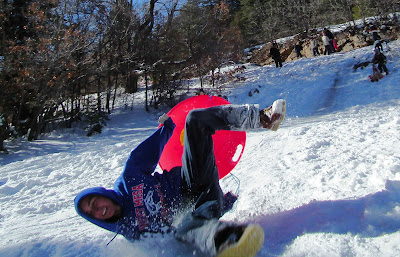 |
| Jeff Roybal, 18, of Santa Fe takes a run at Hyde Memorial State Park during a December 2011 outing. |
“We’ve seen a lot of snow up here lately and the sledding has been great,” says Joe Cristopherson, Superintendent of Hyde Memorial State Park in the mountains just above Santa Fe.
The park boasts a couple of 100-yard sledding runs where adults and kids armed with plastic saucers, toboggans or rubber inner tubes can have a ball whisking down the hill.
No metal sleds or dogs are allowed on the sledding runs for obvious safety reasons, Cristopherson says.
A $5 day use fee is required per vehicle while the purchase of a $40 annual pass will provide unlimited visitation to any and all state parks.
Parents using the sledding run are asked to supervise children and encourage them to wait for others to complete their runs before starting down themselves.
Sledding can be accomplished easily with as little as a stout piece of cardboard but others may want to stop in at Cottam’s Ski Shop located inside the state park’s historic lodge and pick up a plastic saucer or toboggan.
Both cost around $20 and visitors to the sledding hill will also find hot chocolate and other refreshments available inside too, says Lyndsay Cottam.
The lodge features an outdoor patio on the backside where folks can relax and watch sledders coming down the hill.
And while store-bought sleds are convenient, it is the inner tube that reigns supreme amongst serious sledders in New Mexico.
 |
| Photo Courtesy of Tube Pro Inc. Makers of Commercial Grade Snow and River Tubes. |
“We have them on hand especially for those customers,” says Kris Griffin, manager of Discount Tire next to the Horseman’s Haven on Cerrillos Road in Santa Fe.
A rubber inner tube costs from $12 to $20 depending on the size and will provide hours of enjoyment, Griffin says.
And if you’re planning on doing some serious tubing, then there are a couple of spots in northern New Mexico that shouldn’t be missed.
The sledding hill at the Agua Piedra Campground in the Carson National Forest just north of Sipapu Ski Area is, like its brethren at Hyde Park, an old ski run.
One of the first ski areas in the state, the run at Agua Piedra provides cheap thrills in a forested setting on the banks of the Rio Pueblo north of Penasco, says Josie Lopez of the Sipapu Ski Resort.
The store at the ski resort off NM 518 also carries plastic saucers and toboggans as well as groceries and other refreshments, she said.
Sledding is not offered at the ski resort itself.
Those looking for a sunny, gently sloped meadow to sled will find just what they’re looking for on US Hill off NM 518 on the back road to Taos, says Kathy DeLucas, Public Affairs Officer for the Carson National Forest.
This location is a big draw for families because of its gentle nature and great scenery, she says.
Those venturing outside for sledding should expect to work up a sweat while having fun and thus should stayed hydrated, wear appropriate clothing and apply sunscreen too, DeLucas says.
And lastly, those new to the sport should be aware of the inherent rough and tumble nature of the activity and the effect that may have on children.
If You Go: Hyde Memorial State park is located of Hyde Park Rd on the way up to the Santa Fe Ski Area. The Agua Piedra sledding area is located off NM 518 on the road to Mora, just past the Sipapu Ski Resort. Take the highway to Espanola and turn off at NM 76 and follow up to Penasco and then NM 518. US Hill is located off NM 518 also but in the other direction on the road to Taos. An alternate route is following NM 68 out of Espanola, north along the Rio Grande, towards Taos and taking the NM 75 turnoff at Embudo and following to Penasco and on to NM 518.

























































